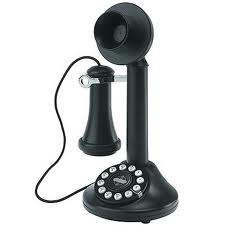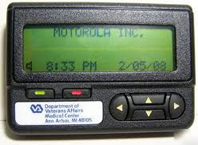Our History
Mobilising Our Members
Getting word to members advising them of a call has changed dramatically over the years, changes driven mainly by technology. One thing, over the years, there has been nothing so disappointing as missing a major call!
1930s Phone and Radio Announcements
Secretary of the brand-new Fire Police Corps, Harry Jane, thought he should be first to know about a fire in his neighbourhood, so he cheekily erected a fire alarm, a red light and below it a press-button on the porch of his home in Newton. This was to be his way of alerting Fire Police of a fire and if ever the alarm went he would phone nearby members to attend. But the fire brigade thought this was one-up-man-ship and told Harry to remove the alarm and to rely on phoned alerts like all the other members.

'Candle' and wall telephones were the norm in the 1930s
That was the basic way to alert members, but in times of the Great Depression not everyone could afford a telephone. So, later, arrangement was made with radio station 1ZB that when Fire Police were required at a fire the Brigade control-room would request an announcement be made, invariably the 1ZB announcer would advise “Fire Police to report to Central Fire Station”, repeated several times between musical items. Listeners must have twigged that there was a major fire in Auckland!

1936 - 1ZB was the first commercial station of the national radio network
1940s War-time
During the Second World War some Fire Police had been recruited as Auxiliary Fire-fighters, on duty overnight at selected suburban stations, augmenting the ranks of paid crews, thinned by those overseas under arms. Dick Reid was one-such member: most evenings he was on duty at Western Districts Station (now the new Ponsonby Station) and while on duty, like other members “on watch” he would monitor fire brigade activity and phone a member or two who would then phone a few more and so on, until sufficient members were responding. The phone was relied on to relay other calls originated by the fire brigade control-room.
1950s Post War Recovery
Phone calls were the main stay in this decade. When there was a major fire the Brigade Control-room would contact a member, usually the Captain, who would then ring around to ensure adequate attendance.

"Use your normal voice when using the instrument"... Post & Telegraph Dept advice 1955
But phones were often hard to get in these post-war recovery years - there were long queues of residents and businesses waiting for phone-lines. Consequently there are copies of many letters on file, cases of the Captain of the day requesting the Chief Postmaster to give members priority to have a phone connected 'so they can fulfil their Fire Police duties'. These letters continued well into the early 1980s, such was the demand for phones in growing Auckland.
1960s Helping Ourselves
The phone remained the main-stay for alerting members. There was an organised telephone contact system, an inverted pyramid, in the late 1960s. Each member rang a couple more, and so on, until everyone who needed to know had been called. But at least 2 other members had their own arrangements with their local fire brigade. When their local fire engine turned out the driver would use a code when sounding the appliance's siren. The Fire Police would thus know the fire engine would be passing their front gate so they would don uniform, rush out to the street just in time to get a lift to the call. Another member had an elaborate system that when he was phoned about a fire he would look on the map to see who he could pick up on the way, phone each member depending on the route he would be taking and arrange to pick them up along the way.
Towards the end of the 1960s there was apparently a roster of Fire Police, those who would take the call from the control-room and pass it on to members. This did not work too well: the control-room did not like changing the number they called and, anyway, some members slept through early morning phone calls from the control-room: Fire Police missed the calls.

Coloured phones became available
1970s Professional Help
Phone calls continued to be somewhat “hit and miss” but carried on until 1976 when the system was changed to a simple, one number to alert Fire Police when a professional call-answering firm, Answer Services Limited offered, without charge, to receive calls, 24 x 7, from the control-room and pass them on to a member of the Fire Police. This became a rostered duty for members... they were to take the call and pass the details on to other members nearest the fire. Even this system did not guarantee response, again there were deep-sleepers on the rostered list and occasionally Answerphone Services, busy, overlooked passing on the vital information.
1980s - Paging
In the mid 1980s the arrangement with Answer Services was reviewed and adjusted after a number of major calls did not somehow get communicated to Fire Police. This did not last long because in August Officers of the Unit were issued with “tone only” pocket pagers: they did not have a screen to display call details. The Brigade control-room activated the pagers, the duty officer phoned the control-room and having ascertained details of the call-out, rang around the members to ensure proper and timely mobilisation. This took time: for a major event demanding “all hands”, and with the growing roll, one person phoning all the members could take nearly an hour! In September a member volunteered to be the permanent turnout officer and he handled all the Unit’s calls: he obtained details from the control-room and alerted appropriate numbers.
In addition, some members invested in radio telephones or radios capable of scanning and over-hearing fire brigade transmissions, and if they heard of an incident to which Fire Police had not been responded, they would advise the duty officer.
1990s Electronics
In 1991 the Unit entered the electronic age for turnout communications when in December members were issued with pocket pagers which alerted members with the address, type of call and any other vital details. There was also a second “channel” for Unit advisories and notices.

The pagers came as a communications package together with hand-held radios.
This revolutionised the turnout process, and the accompanying issue of hand-held radios, simplified and ensured mobilisation of sufficient members, tailored to meet the requirements for each call. At last we weren’t missing any significant calls. Rosters for ‘turnout duties’ were quickly established, a rota of members who from their homes not only managed the mobilisation but operated the radio as the Fire Police’s own mini ‘control-room’ for the duration of the call.
The system, with few modifications, saw us into the new century!
2000s
In January 2000 rearrangements in the Fire Service control-room meant Fire Police pagers were activated directly by control-room operators – for confirmed fires or serious emergencies we found that we were often being paged at the same time as front-line appliances were being mobilised. For developing incidents the control-room updated the information on the pagers, enabling Fire Police officers to ensure appropriate responses.
In 2011 Fire Police became Operational Support - the turn-out arrangement remained the same apart from changes to our name and call-signs.



